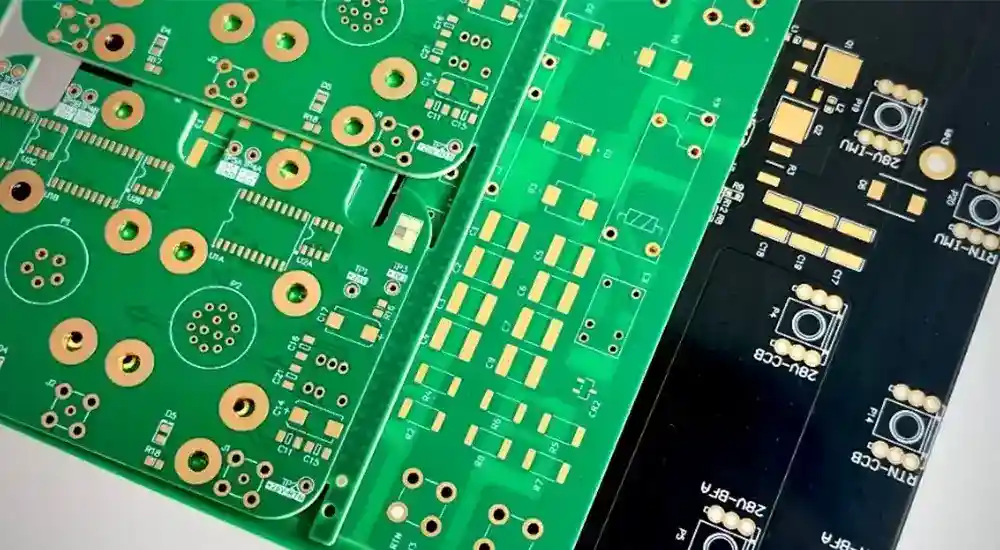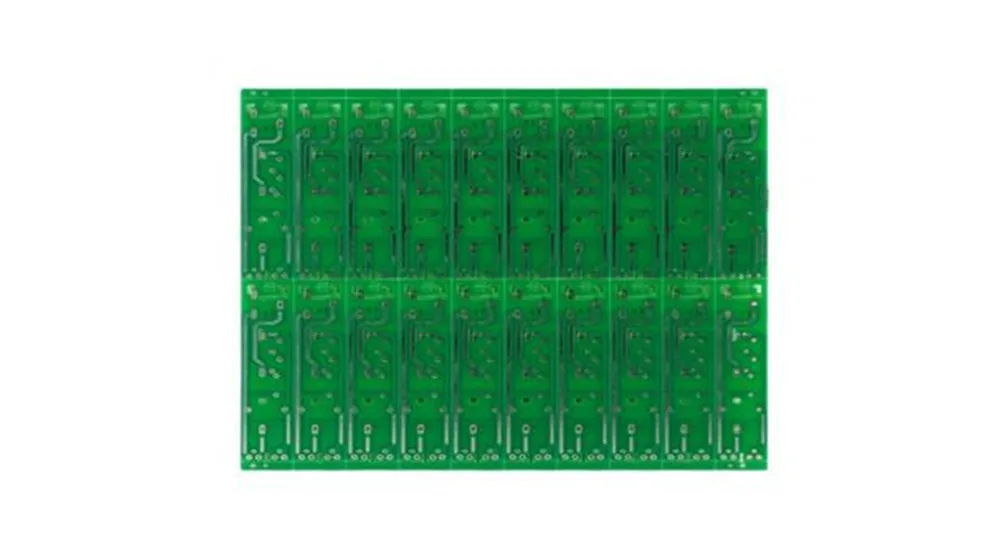
This strategic decision significantly impacts project costs, manufacturing timelines, and final product performance. Understanding the specific advantages, inherent limitations, and optimal application scenarios for double layer printed circuit boards enables informed decision-making that balances technical requirements with commercial objectives.
Why Double Layer PCBs Represent the Optimal Middle Ground
The Circuit Complexity Dilemma
Modern electronic designs often exceed the capabilities of single-layer PCBs, yet do not always justify the complexity and cost of four-layer or six-layer constructions. Single-layer boards impose significant limitations on component density and routing flexibility, often forcing designers to opt for larger board sizes, external jumper wires, or reduced electrical performance. On the other hand, multilayer boards introduce higher costs and extended manufacturing timelines, which may not align with project budgets or deadlines.
Double layer PCBs strike a balance, offering improved routing capabilities and electrical performance while maintaining cost-effective and time-efficient manufacturing processes. This makes them an ideal choice for medium-complexity designs where performance demands surpass the limitations of single-layer boards but where the cost and lead time of multilayer solutions are prohibitive.
Enhanced Design Capability Without Exponential Cost Increases
The key advantage of double layer PCBs is their ability to significantly expand design possibilities without a proportional increase in manufacturing complexity or costs. Transitioning from a single-layer to a double-layer board typically adds 15-30% to manufacturing costs, whereas moving to a four-layer board can often double or triple the production costs.
This cost-to-capability ratio is particularly compelling when considering the challenges of single-layer designs. Complex single-layer boards often require larger sizes, external connections, or additional mechanical assemblies that can exceed the cost difference of switching to a double layer board, all while providing inferior electrical performance and reduced reliability.
Strategic Advantages of Double Layer PCB Implementation
1. Superior Routing Density and Component Integration
Double layer PCBs fundamentally transform circuit layout possibilities by providing dual routing planes that enable significantly higher component densities within constrained board footprints. Designers can implement more sophisticated interconnection schemes, accommodate surface-mount components on both sides of the board, and create more efficient power distribution networks that would be impossible with single-layer constraints.
The enhanced routing flexibility proves particularly valuable in applications requiring dense analog and digital circuit integration. Mixed-signal designs benefit substantially from the ability to separate analog and digital ground systems, implement dedicated power planes for sensitive circuits, and minimize crosstalk through strategic layer utilization and trace routing optimization.
2. Improved Electrical Performance Characteristics
The dual-layer architecture enables several critical electrical performance improvements that directly impact circuit functionality and reliability. Implementing dedicated ground planes or power distribution layers significantly reduces impedance variations, minimizes voltage drops under dynamic loading conditions, and provides superior noise immunity compared to single-layer designs.
Signal integrity improvements manifest through reduced electromagnetic interference, better return current paths, and enhanced thermal performance through increased copper mass. These electrical advantages become particularly pronounced in switching power supplies, motor control circuits, and RF applications where electrical performance directly correlates with overall system functionality and regulatory compliance.
3. Manufacturing Efficiency and Assembly Optimization
Despite increased manufacturing complexity compared to single-layer boards, double layer PCBs often provide superior overall manufacturing efficiency for medium-complexity assemblies. The enhanced component density reduces total board area requirements, minimizing material costs and enabling smaller enclosure designs that reduce overall system costs.
Assembly processes benefit from improved component placement flexibility, allowing optimization of automated pick-and-place operations and reflow soldering profiles. The ability to place components on both board surfaces enables more efficient use of assembly equipment while maintaining accessibility for quality control and testing procedures.
4. Mechanical Reliability and Durability Advantages
Double layer construction inherently provides enhanced mechanical stability through balanced copper distribution that minimizes thermal stress and reduces susceptibility to warpage during assembly and operation. The symmetrical construction helps equalize thermal expansion coefficients between the top and bottom surfaces, reducing mechanical stress that can lead to solder joint failures or trace cracking.
Plated through-hole technology utilized in double layer PCBs creates robust mechanical and electrical connections that demonstrate superior performance under vibration, shock, and thermal cycling conditions compared to single-layer alternatives. This enhanced durability proves essential in automotive, industrial, and aerospace applications where environmental stresses exceed typical consumer electronics requirements.

Understanding Double Layer PCB Limitations and Implementation Challenges
Manufacturing Complexity and Quality Control Requirements
Double layer PCB manufacturing introduces several process complexities that affect production timelines, quality control, and potential failure modes. The requirement for precise layer-to-layer registration during manufacturing necessitates advanced alignment systems and skilled operators to maintain dimensional accuracy across production runs.
The via drilling and plating processes require careful control of hole sizes, plating thickness, and electrical continuity to ensure reliable interlayer connections. These additional process steps introduce potential failure modes, such as incomplete plating, registration errors, and via reliability issues, which demand comprehensive testing and quality assurance procedures.
Quality control becomes more stringent for double layer designs, necessitating automated optical inspection systems, electrical testing protocols, and impedance verification procedures. These measures extend manufacturing timelines and increase production costs compared to single-layer alternatives.
Design Constraints and Performance Limitations
While double layer PCBs offer significant advantages over single-layer designs, they face inherent limitations when compared to multilayer alternatives. These constraints limit their applicability in high-performance applications. The restriction to two routing layers inhibits complex power distribution schemes, sophisticated shielding implementations, and high-density interconnect requirements that may be essential for advanced designs.
Thermal management capabilities remain limited in double layer constructions due to reduced copper mass and fewer thermal conduction paths. High-power applications often require additional thermal management solutions, including heat sinks, thermal vias, or external cooling systems, which add to system complexity and increase costs.
| Performance Parameter | Double Layer Limitation | Typical Workaround | Impact Assessment |
|---|---|---|---|
| Layer Count | Maximum 2 routing layers | Optimize component placement | Moderate design constraint |
| Thermal Conductivity | Limited heat dissipation | External thermal management | Significant for high-power designs |
| EMI Shielding | Reduced shielding options | Strategic ground plane design | Moderate for RF applications |
| Power Distribution | Limited power/ground layers | Careful routing optimization | Moderate for complex power schemes |
Signal Integrity Challenges in High-Speed Applications
Double layer PCBs face significant signal integrity challenges in high-speed digital applications due to limited stackup options that restrict controlled impedance implementations. The lack of dedicated reference planes complicates differential signal routing and reduces the effectiveness of crosstalk mitigation techniques.
High-speed serial interfaces, gigabit networking applications, and precision analog circuits often require multilayer constructions to achieve the necessary signal integrity performance. Double layer designs may struggle to meet timing requirements, noise specifications, or electromagnetic compatibility standards, which are increasingly common in modern electronic systems.
Assembly and Rework Considerations
Component assembly processes become more complex with double layer PCBs, especially when components are placed on both sides of the board. Reflow soldering processes require precise thermal profiling to prevent component displacement during second-side assembly, which may require additional fixtures, adhesives, or modifications to the process, thereby increasing assembly complexity.
Rework and repair operations present additional challenges, as accessing components on the bottom surface of the board may require board removal or specialized equipment. These factors can affect field serviceability and increase manufacturing costs, particularly in applications requiring frequent design modifications or prototyping iterations.
Strategic Decision Framework: When to Choose Double Layer PCBs
Application Categories Optimally Suited for Double Layer Implementation
Double layer PCBs excel in applications that require moderate circuit complexity while maintaining cost sensitivity and reasonable manufacturing timelines. Consumer electronics such as audio equipment, power management systems, and control interfaces are ideal applications where enhanced routing capabilities justify additional manufacturing complexity without requiring multilayer performance characteristics.
Industrial automation systems, automotive electronic modules, and LED lighting controllers benefit significantly from double layer construction due to their typical needs for robust power distribution, moderate signal complexity, and enhanced reliability under environmental stress conditions. These applications align well with double layer capabilities while avoiding the cost premiums associated with multilayer alternatives.
Technical Decision Criteria and Performance Thresholds
The decision to implement double layer PCB technology should be based on several quantitative and qualitative factors that directly impact project success. Circuit complexity metrics, including component count, pin density, and routing congestion, provide objective measures for evaluating whether double layer construction offers meaningful advantages over single-layer alternatives.
Frequency requirements represent another critical decision factor, as applications operating above 10-50 MHz often benefit from improved ground plane implementation and reduced parasitic effects achievable with double layer designs. Power distribution requirements exceeding 5-10 watts typically necessitate the enhanced thermal performance and power routing capabilities that double layer construction provides.
Economic Analysis and Cost-Benefit Evaluation
Economic considerations play a crucial role in the selection of double layer PCBs, requiring comprehensive analysis of direct manufacturing costs, assembly expenses, and system-level implications. While double layer boards typically cost 15-30% more than single-layer alternatives, the enhanced routing density often enables smaller board sizes, offsetting material cost increases through reduced PCB area requirements.
System-level cost analysis should include considerations such as enclosure sizing, connector requirements, and assembly labor impacts. These factors often favor double layer implementations despite higher initial PCB costs. The improved reliability and reduced field failure rates associated with double layer construction can provide significant long-term cost advantages, including reduced warranty costs and enhanced customer satisfaction.
Timeline and Manufacturing Considerations
Project timeline requirements significantly influence PCB layer selection, as double layer manufacturing typically adds 2-5 business days to production schedules compared to single-layer alternatives. Applications with aggressive time-to-market requirements may favor single-layer designs despite performance compromises, while projects with more flexible timelines can capitalize on the advantages of double layer solutions.
Manufacturing partner capabilities also impact feasibility, as double layer PCB production requires more sophisticated equipment and process control than single-layer manufacturing. Supplier qualification and capacity planning become more critical for double layer implementations, particularly in high-volume production environments.
Summary: Maximizing Double Layer PCB Value
Double layer PCBs represent a strategic technology choice that bridges the gap between the simplicity of single-layer limitations and the complexity and expense of multilayer constructions. Their optimal value proposition is most evident in applications that require enhanced circuit density, improved electrical performance, and superior mechanical reliability, all while maintaining reasonable manufacturing costs and production timelines.
The key to successful double layer PCB implementation lies in recognizing when project requirements exceed the capabilities of single-layer boards but do not demand the performance characteristics of multilayer solutions. This sweet spot spans a wide range of modern electronic applications where performance and cost considerations drive design decisions.
Understanding both the advantages and limitations of double layer technology enables informed decision-making, ensuring optimal project outcomes through careful technology selection. When properly applied, double layer PCBs offer enhanced functionality, improved reliability, and superior cost-effectiveness, which can provide significant competitive advantages in today’s fast-paced electronics market.
Optimize Your Next Project with Haoyue Electronics’ Double Layer PCB Solutions
At Haoyue Electronics, we understand that choosing the right PCB technology for your application requires a balance of performance, cost, and timeline considerations. Our experienced engineering team specializes in optimizing double layer PCB designs, ensuring manufacturing excellence, and providing comprehensive assembly services to maximize the success of your project.
With advanced manufacturing capabilities, we guarantee consistent quality across production runs while maintaining competitive pricing and reliable delivery schedules. Whether you’re working on industrial control systems, consumer electronics, or automotive applications, we offer the technical expertise and production excellence needed to bring your designs to life efficiently and cost-effectively.
Contact our engineering team today to learn how our double layer PCB solutions can elevate your project’s performance while optimizing costs and timelines.
FAQ
1. What is the typical cost increase when moving from single layer to double layer PCBs?
Double layer PCBs typically cost 15-30% more than single layers. However, the increased routing density can reduce material costs, and improved performance often eliminates the need for extra components, reducing overall system costs.
2. How do manufacturing lead times compare between single layer and double layer PCBs?
Double layer PCBs generally add 2-5 business days to the production schedule due to extra drilling and plating steps. The impact is minimal for prototypes but may be more significant for high-volume runs.
3. Can existing single layer designs be easily converted to double layer PCBs?
Converting to double layer requires layout adjustments, including optimized component placement and trace routing. This improves performance, but mechanical factors like board thickness and enclosure fit must also be considered.
4. What design rules and constraints should be considered when developing double layer PCB layouts?
Key considerations include via sizing (0.2-0.3mm), trace spacing for manufacturing tolerance, and thermal relief patterns. Power and ground planes must be designed for current capacity and minimal voltage drop.
5. At what point does design complexity justify moving from double layer to multilayer PCBs?
Multilayer PCBs are needed when designs exceed 200-300 signal connections, require frequencies above 100-200 MHz, or need complex power distribution or electromagnetic shielding.

